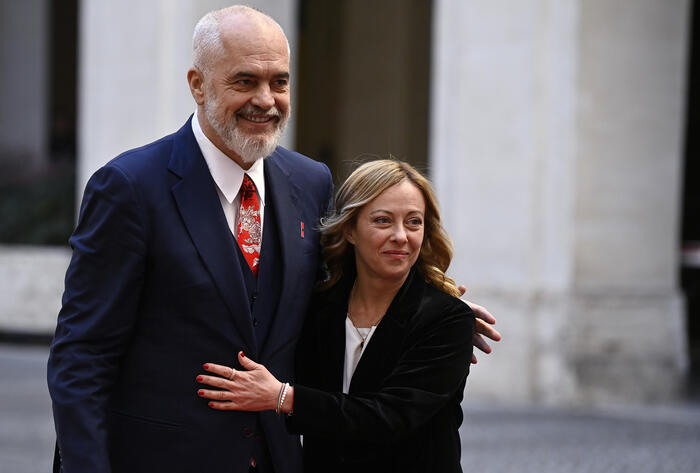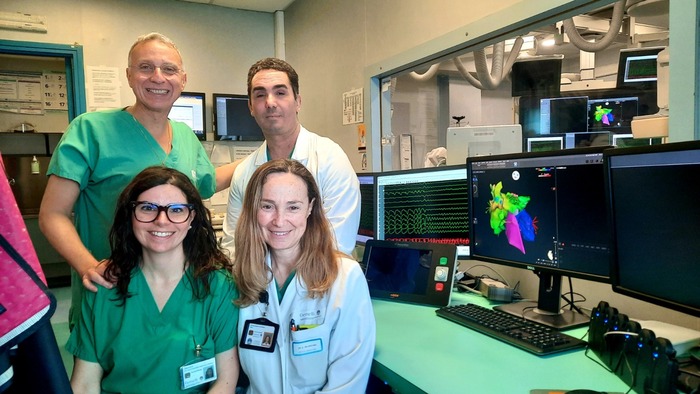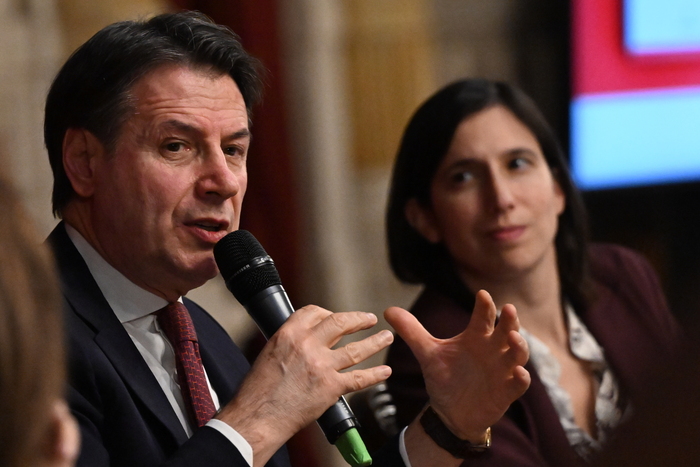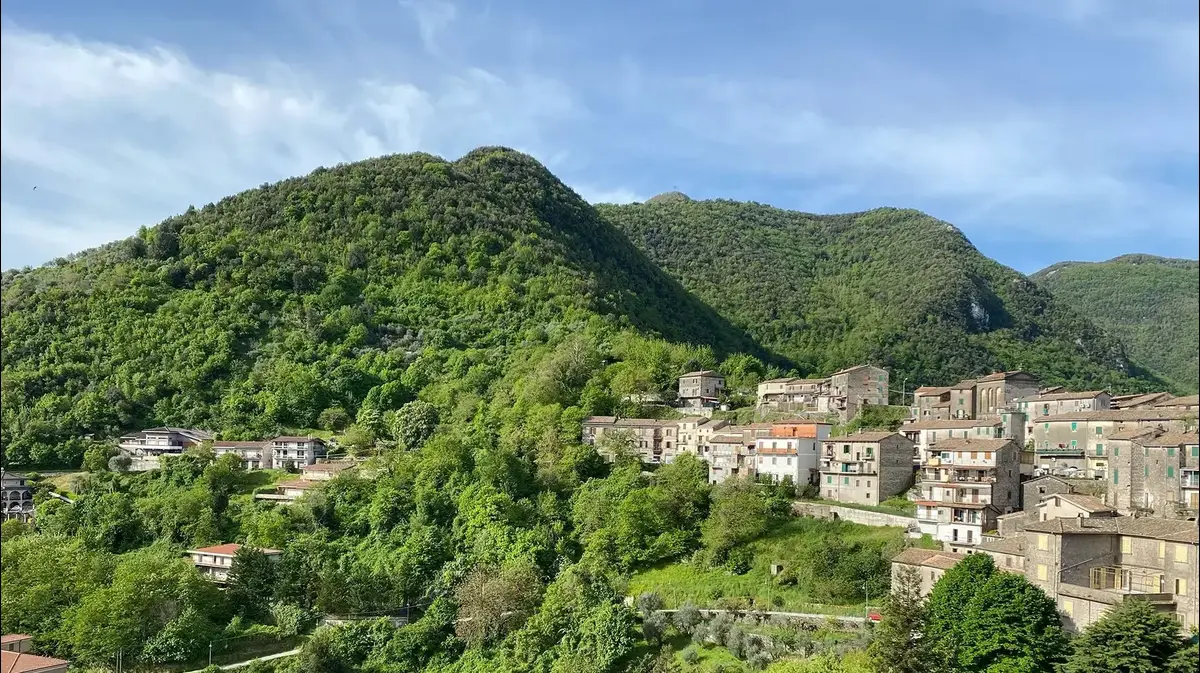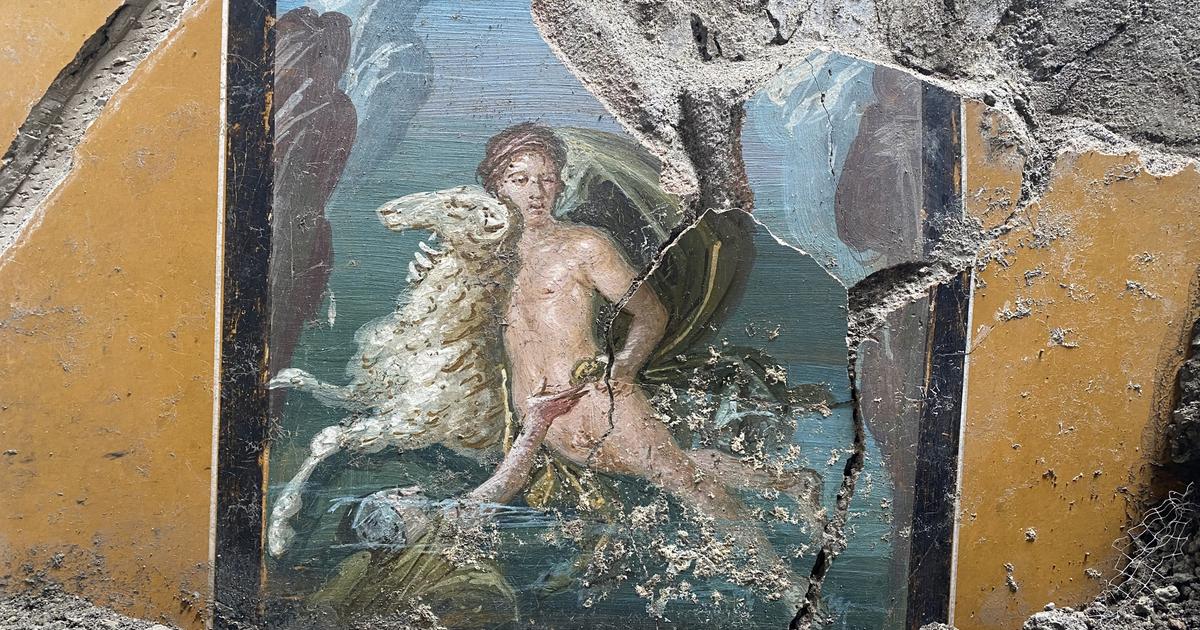According to legend, Rome was born on April 21, 753 BC, when Romulus, the survivor of the two rival founders, hitched up his plow and drew a circular perimeter in the hills above the Tiber River.
All that was inside was
urbs
, the space of the city consecrated by the priests who interpreted the will of the gods;
all that was outside was ager, open unconsecrated territory.
"We have a city founded by auspices and omens," wrote the Roman historian Livy.
"There is no corner of it that is not filled with our cults and our gods."
View of Rome from Piazzale Caffarelli, April 2023. Christianity is just one chapter in the Eternal City's rich spiritual history: Judaism, Islam and ancient Roman religions are also part of it.
(Martin Pauer/The New York Times)
Rome, in a sense, has been
holy ground from the beginning.
For many, Rome is the epicenter of Catholicism, the seat of the Vatican, and home to a seemingly infinite number of churches.
But in the nearly three millennia of the city's history,
Christianity
is but a chapter.
Rome has been home to polytheistic pagans and monotheistic Jews, followers of Near Eastern cults, and, more recently, a sizeable multinational Muslim community.
All of them have left traces -altars, temples, sanctuaries, mosques, inscriptions-, some of disturbing beauty, others erased ad nauseam.
Ostia Antica, an archaeological park that includes the majestic ruins of an ancient synagogue, in Rome, April 2023. Christianity is just one chapter in the Eternal City's rich spiritual history: Judaism, Islam, and ancient religions Romans are also part of it.
(Martin Pauer/The New York Times)
Since Rome is Rome, these holy places are often mixed or overlapping:
a church dedicated to the Virgin over pagan temples;
a medieval church built on top of an old house that had a shrine to the Persian sun god Mithras in its basement.
If you know where to look or what you're looking for, you'll find many of these shrines in the historic center, although some require short excursions by train or car.
Most of the pilgrims to the Eternal City declare their victory upon reaching
Saint Peter's Square
.
But Rome and its surroundings hide many sacred places that are beyond the knowledge of the Bible.
The Great Mosque in the Parioli neighborhood of Rome, April 2023. Christianity is just one chapter in the Eternal City's rich spiritual history: Judaism, Islam and ancient Roman religions are also part of it.
(Martin Pauer/The New York Times)
Ancient Rome: A divine mix of beliefs
If you think Roman religion was essentially Greek mythology with Latinized names, think again.
The pagan polytheism of ancient Rome was dizzyingly complicated, and the gods were seen as constant companions who hovered over the city's mortal residents from birth to death, communicating with them ceaselessly but obliquely from their temples and shrines.
The best way to understand this divine tangle is to take a walking tour.
Begin at the
top of the Capitol,
the holiest of Rome's seven hills and the center of the ancient city.
Pass through an archway on the south side of
Piazza del Campidoglio
, the work of Michelangelo, and ascend the winding cobbled alleyway to its junction with Via
del Tempio di Giove
.
It is located in the place where the most important religious monument of ancient Rome was erected, the Temple of the Capitoline Triad: Jupiter Optimus Maximus, Juno Regina and Minerva.
The Basilica of San Bartolomeo all'Isola, located on the site of a temple dedicated to Aesculapius, the god of healing, in Rome, April 2023. Christianity is just one chapter in the Eternal City's rich spiritual history : Judaism, Islam and ancient Roman religions are also part of it.
(Martin Pauer/The
Nothing remains of the immense temple except a single painted tile and a few tuff foundation blocks dating from the 6th century BC (a large part is preserved in the Capitoline Museums).
But if you turn your back on the tangle of government buildings and small parking lots that now clutter the summit and gaze at the Forum through the flickering gray-green olive trees, you can feel the wing of a god.
"There was a definite hierarchy among the Roman gods," says Licia Ferro, a classical anthropologist and co-author of
"Miti Romani" ("Roman Myths"
).
"The main gods lived on high and had their temples in the Roman Forum. But there were also lesser terrestrial deities."
The Basilica of San Bartolomeo all'Isola, located on the site of a temple dedicated to Aesculapius, the god of healing, in Rome, April 2023. Christianity is just one chapter in the Eternal City's rich spiritual history .
This hierarchy is apparent as you head south, past the Area Sacra di
Sant'Omobono
(an archaeological site with the foundations of two ancient temples), to the Forum Boarium, the port and cattle market of the classical city.
Here, opposite the delicate eighth-century Basilica of Santa Maria in Cosmedin, stand two perfectly intact Roman temples dedicated to lesser gods:
the circular, toy-like Temple of Hercules Victor, and the adjoining Temple of Portunus, sacred to the god of keys, doors, and cattle.
Roman merchants, fervent worshipers of Hercules, swore by the divine hero when they concluded business deals by placing a hand on his Ara Maxima, an immense altar whose podium has been preserved in the crypt of
Santa Maria in Cosmedin.
The surrounding neighborhood, anchored by the shaggy marble facades of the
Arch of Janus
, is ideal for the contemplative stroll.
With a good guide, you will be able to travel back in time through the years.
The Temple of Hercules Victor, located in the Forum Boarium, which was a bustling trading center in ancient times, when many Roman merchants were fervent worshipers of Hercules, in Rome, April 2023. Christianity is just one chapter of the rich spiritual history of the Eternal City: Judaism, Islam and ancient Roman religions are also part of it.
(Martin Pauer/The New York Times)
A short walk along the Tiber and across the Ponte Fabrizio pedestrian bridge will take you to
Tiber Island
, sacred to Aesculapius, the god of healing.
The elegant Baroque Basilica of San Bartolomeo all'Isola stands on the site of the god's temple, and the carved marble cylindrical well before the church's high altar supposedly conceals a well that leads to the temple's healing spring.
A hospital, the 16th-century Ospedale Fatebenefratelli, perpetuates the island's healing arts.
The site is doubly sacred due to the fact that doctors hid Roman Jews here during the
Nazi occupation,
claiming they were carriers of a contagious (and fictitious) disease called K Syndrome.
Trees on Via del Tempio di Giove, the site of the Temple of the Capitoline Triad, in Rome, April 2023. Christianity is just one chapter in the Eternal City's rich spiritual history: Judaism, Islam, and the Ancient Roman religions also figure prominently.
(Martin Pauer/The New York Times)
Jewish Rome: Catacombs and Cellars
Rome's Jewish community, the oldest in Europe, dates back to the second century BC, and in imperial times the capital was home to tens of thousands of Jews, most of them crammed into brick apartment blocks in the Trastevere neighborhood
.
.
"In ancient Rome there were no ghettos," says Elsa Laurenzi, a classical archeology researcher.
Not a trace remains of the 11 or 12 synagogues that served this vibrant polyglot community.
The Trastevere site identified as Rome's oldest synagogue - a humble brick house with a small arched loggia on the narrow, cobbled
Vicolo dell'Atleta,
14
- is not classical, but medieval.
The Tempio Maggiore (Great Synagogue), across the Tiber, looks ancient but is actually a Greco-Babylonian pastiche from 1904. (Guided tours are available through the adjoining Jewish Museum of Rome; to attend the Shabbat, you must register in advance).
The Great Mosque in the Parioli neighborhood of Rome, April 2023. Christianity is just one chapter in the Eternal City's rich spiritual history: Judaism, Islam and ancient Roman religions are also part of it.
(Martin Pauer/The New York Times)
Ostia Antica, the ancient port of Rome (an hour by train from Ostiense station) and today one of the largest and best-preserved archaeological parks in Italy, is the site of an ancient synagogue.
The majestic ruin stands alone in a grassy expanse laced with cypress and stone pine trees.
Enter the sanctuary between intact columns (look for the relief of a menorah protruding from one of the capitals), walk on the black-and-white mosaic floors, and peer into a marble well that may have been part of the mikvah.
You probably have the place to yourself.
The Vigna Randanini Catacombs, off the Via Appia Antica (a 10-minute taxi ride from the
Baths of Caracalla)
, are one of five Jewish catacombs to have been excavated near Rome, and the only one open to the public (contact for details). -appia@cultura.gov.it).
Elsa Laurenzi, who has written about the Jewish catacombs in Rome, points out that the Jews did not go to the catacombs to pray, considering the cemeteries impure.
But today, just standing next to the little tuff niche where a Jewish girl was buried 2,000 years ago is a kind of prayer.
"Sleep here in peace: she was deeply loved," reads the Greek inscription on a marble plaque engraved with Jewish symbols: a palm branch, a menorah, a shofar.
A painting in Rome's Mithreo Marino, April 2023. Christianity is just one chapter in the Eternal City's rich spiritual history: Judaism, Islam and ancient Roman religions also figure prominently.
(Martin Pauer/The New York Times)
Isis and Mitra: Gods of distant lands
The Romans, tolerant of foreign religions, imported two gods who became very popular during the imperial period: the Egyptian deity Isis (a divine mother who carried her dead husband, the fertility god Osiris, to the afterlife) and Mithras, the god of light from Indo-Iranian mythology.
"Isis was a sexy pagan version of the Virgin," says Enrico Ducrot, an archaeologist who now runs his family's travel company, Viaggi dell'Elefante.
"Her appeal is still so fundamental that it hits you right away."
It has indeed impacted him.
Ducrot grew up not far from the Pantheon, near the Iseum Campense, the largest Roman temple dedicated to Isis.
Although the temple has been lost under successive urban layers, the pink and red granite obelisks and statues plundered from the complex (many of them erected in city squares and exhibited in the Capitoline and Vatican museums) give an idea of its scale and opulence.
Part of the massive travertine wall and entrance arch of the temple was recently discovered under a building owned by Ducrot.
It changed his life.
At the end of next year, he hopes to open the
Iseum,
a museum dedicated to the history of the cult.
Ostia Antica, an archaeological park that includes the majestic ruins of an ancient synagogue, in Rome, April 2023. Christianity is just one chapter in the Eternal City's rich spiritual history: Judaism, Islam, and ancient religions Romans are also part of it.
(Martin Pauer/The New York Times)
Apparently, Isis appealed to the Roman elite, but Mithras was the preferred god of workers and battle-hardened legionaries (the cult excluded women).
Traditional Roman temples stood high, like the Temple of the Capitoline Triad, and opened to the sky through colonnaded porticoes or an oculus, but the mithrai were the opposite: underground, narrow, hidden under houses, illuminated only by flickering torches.
According to cultural anthropologist Roberto Libera, director of the Museo Diocesano di Albano, the idea that the rituals held in these caves of holy men culminated in the sacrifice of a bull is probably wrong.
The iconic image of Mithras kneeling on a bull and thrusting a dagger into its neck was most likely intended to inspire fear and fervor.
Given the large number of Mithraic sanctuaries, it is surprisingly difficult to visit one.
The Basilica of San Clemente, near the Colosseum, preserves a mithraeum in its sub-cell, but the most interesting sanctuary of the Circus Maximus is only (and rarely) open for group visits.
One notable exception requires a 40-minute drive south of Rome, in the Alban Hills:
The Marine Mithraeum, discovered in 2005, features a remarkably intact wall painting of the god-man in a cap, sequins and pink leggings depicting the bull-stabbing scene.
The museum is open almost every weekend.
Islamic Rome: Big Show and Silent Struggles
Islamic presence in Italy dates back to the eighth century, but it wasn't until 1995 that the officially recognized Great Mosque of Rome opened in Parioli, a neighborhood just a short taxi ride from the Borghese
Gallery
.
The largest mosque in Europe, the mosque is a low, bright, modern structure that bridges the gap between East and West.
A fountain near the entrance refreshes a piazza whose pavement recalls the dazzling geometry of Michelangelo's Campidoglio, and the rows of twin pillars leading to the travertine-clad sanctuary recall Bernini's monumental colonnade in St. Peter's
Square
.
The interior is a study in curving lines, with low, circular chandeliers surrounding the central dome, intricately tiled walls, and a rich Persian rug swirling on the floor.
You enter with the song of the birds, pray in a bright rotunda and exit the enclosure into a grove of pines and cypresses on the borders of luxurious Parioli.
Except when a train goes by, it is a lush and quiet place.
Maybe too much.
Rome's growing Islamic community, many of them immigrants from Morocco, Bangladesh, Albania or Senegal, resides on the other side of the city, in the bustling squares near Termini Station.
For most Roman Muslims, attending Friday services at the Grand Mosque would require taking a
day off
work.
"The Great Mosque is a masterpiece, a symbol, a place of pride," says Imam Yahya Pallavicini, president of COREIS (Italian Islamic Religious Community).
"But Muslims in the city often pray in unofficial neighborhood mosques, often located in private homes or garages."
On any given Friday in the Greater Mosque, hundreds of people gather in a space built for thousands.
The difficulty contemporary Muslims have in finding state-sanctioned Roman places of worship is reminiscent of the plight of early Christians in Rome.
Unlike the Jews and the followers of Mithras and Isis, Christians were violently persecuted, and some of Rome's earliest churches, including St. Peter's, are martyriums: places where saints were killed for their beliefs.
The churches of
Santa Sabina,
Santa Prassede, Santa Pudenziana and Sant'Agnese Fuori le Mura were also sanctified by suffering.
With their crystalline mosaics and their fine, pure light, these humble-elegance basilicas evoke the time when a strange, fervent, and inflexible new cult rose from the ashes of empire.
Every age, every faith, every pilgrim makes Rome sacred anew.
c.2023 The New York Times Company
look also
"The Thames is a great washing machine of history"
The Garbage War in Rome


